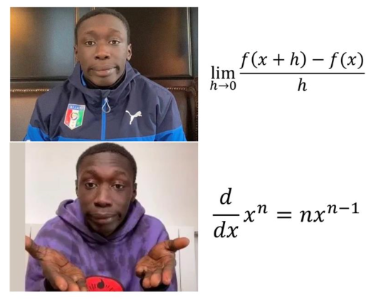Derivative of x^n
Keywords
| Derivative | 微分 | 미분 | 导数 |
| Function | 関数 | 함수 | 函数 |
| Exponent | 指数 | 지수 | 指数 |
| First principles | 基本原理 | 기본 원리 | 基本原理 |
| Polynomial | 多項式 | 다항식 | 多项式 |
| Coefficients | 係数 | 계수 | 系数 |
| Limit | 極限 | 극한 | 极限 |
| h term | h項 | h 항 | h项 |
| Power rule | 累乗法則 | 거듭제곱 법칙 | 幂规则 |
| Differentiation | 微分法 | 미분법 | 微分 |
| General rule | 一般規則 | 일반 규칙 | 一般规则 |
| Efficiency | 効率性 | 효율성 | 效率 |
| n from 1 to 10 | 1から10までのn | n을 1부터 10까지 | n从1到10 |
| Expanded form | 展開形 | 전개된 형태 | 展开式 |
| Derivative function | 導関数 | 미분 함수 | 导函数 |
| Original exponent | 元の指数 | 원래의 지수 | 原指数 |
| Using first principles | 基本原理を用いて | 기본 원칙 사용하기 | 使用基本原理 |
| Finding derivatives | 導関数の求め方 | 미분 찾기 | 求导数 |
| Factual Questions | Debatable Questions | Conceptual Questions |
| 1. What is the power rule for differentiation as stated in the document? | 1. Is the power rule always the most efficient method for finding derivatives of polynomials? | 1. How does the concept of limits underpin the definition of a derivative? |
| 2. According to the procedure, what does represent? | 2. Can the process used in first principles be considered more educational than using the power rule? | 2. Why does the term disappear when taking the limit as approaches zero? |
| 3. What pattern in coefficients is observed when expanding ? | 3. Is the differentiation of functions of the form where is a positive integer inherently simpler than other types of functions? | 3. In what way do the coefficients of a polynomial function relate to its derivative? |
| 4. How is the derivative function calculated from first principles for ? | 4. Should the first principles method be taught before introducing rules like the power rule? | 4. What does it mean for a function to be differentiable? |
| 5. What is the general rule formulated for the derivative of based on the mini-investigation? | 5. Could there be a better approach to teaching derivatives than the methods currently used? | 5. How does differentiating a polynomial affect its degree and the nature of its graph? |
Mini-Investigation: Exploring the Derivative of
Objective:
To understand how the derivative of the function changes as we vary the exponent n.
Procedure:
1. Start with the function f(x) = , where n is a positive integer.
2. Utilize the definition of the derivative from first principles:
Investigation Steps:
- Slide the value of n from 1 to 10 and record the derivative for each value of.
- Use the applet to expand and to observe the patterns in the coefficients of the resulting polynomial.
Analysis:
1. Observe the coefficients of the terms in the expanded form of .
2. Note how the h term disappears as we take the limit as h approaches zero, leaving us with the derivative function.
3. Relate the coefficients of the derivative to the original exponent .
Conclusions:
- Formulate a general rule for the derivative of based on the patterns observed.
- Discuss how the power rule for differentiation, , arises from the investigation.
- Reflect on the efficiency of using first principles versus the power rule for finding derivatives.

Part 2 - The power rule - Differentiating polynomials
In practice it's not necesary to always differentiate from first principles. The power rule can be used directly, so we are able to differentiate any polynomials quickly. Watch the following video.
1. What is the derivative of with respect to ?
2. If , what is ?
3. Differentiate with respect to .
4. What is the derivative of with respect to ?
5. If g(x) = , what is ?
6. What is the derivative of with respect to ?
7. What is the derivative of with respect to ?
